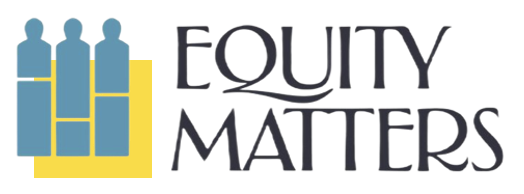Navigating Change Together
Change is inevitable in education, whether it’s adopting a new curriculum, implementing policy shifts, or responding to evolving student needs. But navigating these transitions successfully requires more than just planning; it demands intentionality, inclusion, and a focus on building a cohesive and supportive community.
At Equity Matters, we know that the heart of successful change lies in the strength of your school’s relationships and culture. Our Equity Consultants share their insights on fostering unity, trust, and collaboration during times of transition. From practical strategies to powerful beliefs, this post provides actionable advice for leaders committed to guiding their teams through change while maintaining focus on what matters most—students.
Whether you're implementing a new system or navigating uncharted territory, these perspectives will empower you to approach change with confidence, clarity, and compassion. Let’s dive into the practices that turn change into an opportunity to grow stronger together.
What is one belief, strategy, or practice you recommend for building a cohesive and supportive school community when navigating significant changes?
Dr. Kristen Taylor, Lead Equity Consultant
"Remember, all voices matter in this process to shape the path forward. True and effective transformation requires inclusion of all voices - and actively creating opportunities for diverse perspectives to be heard and valued helps limit the stress of being a decision maker. Use the voices of your stakeholders to help you shape how and what changes are implemented!"
Dr. Jamie Martin, Equity Consultant
Nothing impacts a teacher's workload like new curriculum/systems! Administrators can make an intentional effort to ease the burden in several ways:
1—Districts might consider asking some teacher leaders to pave the way by sharing their insights/materials with their grade level counterparts across the district, either through PD, a new page on the district's website, a newsletter, or a even a shared file system. Where possible, these leaders can be offered a title and stipend, but creative benefits might also sweeten the deal (preferential parking, duty free Fridays, etc.)
2—Arrange time for teachers to observe one another and to have extra prep time during the school day where possible. Invite open-ended reflection and make space in your next staff meeting for staff to share out their experiences/impressions.
3—Small kindnesses go a long way. Seek for moments where your staff can unwind, such as a potluck or other social activity. Snag some donuts for the staff room with a positive note, or send each teacher a personal note of encouragement/praise specifically mentioning their lesson plans or flexibility in adapting to the changes. (Pro tip: Businesses in your area would love to know that teachers need something extra this year. They may even donate a meal or some freebies your staff would enjoy.)
Mrs. Tashanae Francis, Equity Consultant
"To discover which improvement initiatives really make a difference, school leaders can tap into data, feedback, and regular check-ins. It all starts with clear goals—think boosting attendance by 5% or cutting down disciplinary issues by 10%. Keep an eye on key metrics like test scores, behavior trends, and graduation rates, while also checking in on how teachers, students, and parents feel through surveys, focus groups, and interviews. Pop into classrooms to see the magic in action and use real-time dashboards to spot trends and celebrate wins. Regular review meetings help teams adjust plans as they go, making sure every initiative stays on track. By mixing data with real-world insights, schools can see what works, tweak what doesn’t, and keep the momentum going toward positive change!"
Dr. Terrance Scott, Equity Consultant
"To establish a cohesive and supportive school community, we must center the voices of those we serve and operate from a restorative lens. Intrinsic motivation is built when relationships are prioritized with student voice at the center. When we make school a place everyone WANTS to be, not just because they have to be there, students will work hardest because they believe they are cared for and trust your judgment. Let's reframe our structures and supports so we do things WITH them, rather than to them or for them, leading to those coveted academic outcomes."
Dr. Sherrie Robbins, Equity Consultant
"One practice I recommend is to stay curious and encourage curiosity. When we remain curious, we push ourselves to stay open minded. Curiosity requires us to ask questions and seek responses from diverse perspectives. Curiosity requires us to listen to learn, rather than listen to respond. Curiosity prevents us from making assumptions and quick judgments based on our own lens and viewpoints. Best of all, when we remain curious, we model curiosity for those around us."
Mr. Marques Harris, Equity Consultant
"The ability to lead with transparency and authenticity is the most effective strategy when having to mitigate and manage the results of significant changes or shifts. Leaders should prioritize honesty and consistent communication as to the what, when, how and why of anything that impacts the lives of children and thus, their families. Honesty creates trust which in turn functions as the glue for any cohesive coalition of folks. When you ask people to trust you and your leadership, you have a duty to return their trust with clarity on what's happening and what it means for students."
Mrs. Amy Youngblood, Equity Consultant
"I’ve been listening to a podcast about Boeing. Pilots used to say “if it’s not Boeing we’re not going”. Then a merger happened with McDonnell Douglas and shareholder profits became more important than culture. They didn’t listen to their people and disaster came knocking. When implementing changes, whether curriculum or policy talk to your people both before you make the changes but especially while you are making them. Listen to the people telling you that something isn’t working, ask questions, find out why. Because while Boeing may only hold your life in their hands four or five times a year, depending on how much you fly, our students lives are in our hands everyday. Their lives depend on all of us doing the very best every day."
Dr. Sheldon McAfee, Equity Consultant
"The family that prayers together, stays together."
"This quote from one of my favorite movies captures my belief for cohesiveness and smooth transition. I was taught a prayer is an open line of communication to the director of the universe. I call him God. But prayer is secretly used to bring others into alignment with your vision. A prayer is a meeting a leader has with those whom they need to share information with. Once in a while, call a "prayer meeting." Say to your team out load the beliefs and vision you have, and allow them to make it a "cooperate prayer" and tag along their beliefs and vision for the team. Once these collective agreements or "prayers" are heard, they can't be unheard. Get your team together and have an open discussion about your beliefs and the vision for your team, school and organization!"










